Musculoskeletal and Sociodemographic Gender Differences between Vocational Ballet Students
Abstract
1. Introduction
2. Materials and Methods
3. Results
3.1. Sociodemographic Characteristics
3.2. Body Weight
3.3. Physical Examination
3.3.1. Dorsiflexion of the Index Finger
3.3.2. Trunk
3.3.3. Legs and Hips
3.3.4. Foot-Ankle Complex
4. Discussion
4.1. Age
4.2. Body Weight
4.3. Beginning with Ballet and Training
4.4. Physical Examination
4.4.1. Mobility of the Index Finger
4.4.2. Trunk
4.4.3. Legs and Hips
4.4.4. Foot-Ankle Complex
5. Conclusions
Author Contributions
Funding
Institutional Review Board Statement
Informed Consent Statement
Data Availability Statement
Acknowledgments
Conflicts of Interest
References
- Liechtenhan, R. Vom Tanz zum Ballett: Geschichte und Grundbegriffe des Bühnentanzes, 2nd ed.; Belser: Stuttgart, Germany, 1993. [Google Scholar]
- Tarassow, N.I. Klassischer Tanz: Die Schule des Tänzers; Henschel: Berlin, Germany, 1974. [Google Scholar]
- Rossol, M.; Hinkamp, D. Hazards in the theater. Occup. Med. 2001, 16, 595–608. [Google Scholar] [PubMed]
- Arendt, Y.D.; Kerschbaumer, F. Verletzungen und Überlastungserscheinungen im professionellen Ballett. Z. Orthop. Ihre. Grenzgeb. 2003, 141, 349–356. [Google Scholar] [CrossRef] [PubMed]
- Wanke, E.M.; Mill, H.; Groneberg, D.A. Ballett als Leistungssport—Gesundheitliche Gefährdungen am Beispiel akuter Verletzungen bei Tanzschülern. Sport. Sportschaden 2012, 26, 164–170. [Google Scholar] [CrossRef] [PubMed]
- Wolf, A.S. Zur Problematik des Leistungssports bei Heranwachsenden. Arch. Gynecol. Obs. 1987, 242, 936–943. [Google Scholar] [CrossRef]
- Exner-Grave, E. TanzMedizin: Die Medizinische Versorgung Professioneller Tänzer; Schattauer: Stuttgart, Germany, 2008. [Google Scholar]
- Wanke, E.M.; Exner-Grave, E. Tanz mit Spitzenschuhen: Besonderheiten, körperliche Voraussetzungen und Tauglichkeitskriterien. Sport. Sportschaden 2017, 31, 213–221. [Google Scholar] [CrossRef]
- Hamilton, W.G.; Hamilton, L.H.; Marshall, P.; Molnar, M. A profile of the musculoskeletal characteristics of elite professional ballet dancers. Am. J. Sport. Med. 1992, 20, 267–273. [Google Scholar] [CrossRef] [PubMed]
- Fuchs, E.; Hess, H.; Kunz, M. Akute Verletzungen und chronische Überlastungen im klassischen Ballett. Sports Sportschaden 2003, 17, 123–131. [Google Scholar] [CrossRef]
- Smith, P.J.; Gerrie, B.J.; Varner, K.E.; McCulloch, P.C.; Lintner, D.M.; Harris, J.D. Incidence and Prevalence of Musculoskeletal Injury in Ballet: A Systematic Review. Orthop. J. Sport. Med. 2015, 3, 2325967115592621. [Google Scholar] [CrossRef]
- Yau, R.K.; Golightly, Y.M.; Richardson, D.B.; Runfola, C.D.; Waller, A.E.; Marshall, S.W. Potential Predictors of Injury Among Pre-Professional Ballet and Contemporary Dancers. J. Danc. Med. Sci. 2017, 21, 53–63. [Google Scholar] [CrossRef]
- Caine, D.; Goodwin, B.J.; Caine, C.G.; Bergeron, G. Epidemiological Review of Injury in Pre-Professional Ballet Dancers. J. Danc. Med. Sci. 2015, 19, 140–148. [Google Scholar] [CrossRef]
- Ekegren, C.L.; Quested, R.; Brodrick, A. Injuries in pre-professional ballet dancers: Incidence, characteristics and consequences. J. Sci. Med. Sports 2014, 17, 271–275. [Google Scholar] [CrossRef] [PubMed]
- Huwyler, J. Der Tänzer und Sein Körper: Aspekte des Tanzens aus Ärztlicher Sicht, 2nd ed.; PERIMED-Spitta: Balingen, Germany, 1995. [Google Scholar]
- Kabakci, A.G.; Yücel, A.H.; Ayvazoglu, S. Physical characteristics of students to receive ballet training. Cukurova Med. J. 2017, 41, 55–60. [Google Scholar] [CrossRef]
- Kadel, N.J.; Donaldson-Fletcher, E.A.; Gerberg, L.F.; Micheli, L.J. Anthropometric Measurements of Young Ballet Dancers. J. Danc. Med. Sci. 2005, 9, 84–90. [Google Scholar]
- Hamilton, D.; Aronsen, P.; Løken, J.H.; Berg, I.M.; Skotheim, R.; Hopper, D.; Clarke, A.; Briffa, N.K. Dance training intensity at 11–14 years is associated with femoral torsion in classical ballet dancers. Br. J. Sport. Med. 2006, 40, 299–303; discussion 303. [Google Scholar] [CrossRef]
- McCormack, M.; Briggs, J.; Hakim, A.; Grahame, R. Joint laxity and the benign joint hypermobility syndrome in student and professional ballet dancers. J. Rheumatol. 2004, 31, 173–178. [Google Scholar]
- Sonnenkalb, E. Einstellungsuntersuchungen für die Palucca-Schule Ergebnisse und Schlussfolgerungen. Arb. Inf. Für Theater Und Orch. Des Betr. Der Berl. Bühnen Und Der Arb. Berat. Der Theater Und Orch. Der DDR (BABB/AHB) 1984, 1, 24–28. [Google Scholar]
- Tamaschke, C. Anthropometrische Körperbaustudien an Schülerinnen der Staatlichen Ballettschule Berlin. Ärztliche Jugendkd. 1973, 69, 9–17. [Google Scholar]
- Nilsson, C.; Wykman, A.; Leanderson, J. Spinal sagittal mobility and joint laxity in young ballet dancers. A comparative study between first-year students at the Swedish Ballet School and a control group. Knee Surg Sports Traumatol. Arthrosc. 1993, 1, 206–208. [Google Scholar] [CrossRef]
- Huwyler, J. Ärztliche Eignungsprüfung zu einer tänzerischen Berufsausbildung. Ballettjournal 1989, 37, 56–61. [Google Scholar]
- Geschichte. Available online: http://www.john-cranko-schule.de/ueber-uns/geschichte/ (accessed on 14 December 2022).
- Rippstein, J. Le Plurimètre V64: Un nouvel instrument de mensuration. Ann. De Kinésithérapie 1983, 10, 37–45. [Google Scholar]
- Kromeyer-Hauschild, K.; Wabitsch, M.; Kunze, D.; Geller, D.; Geiss, H.; Hesse, V.; von Hippel, A.; Jaeger, U.; Johnsen, D.; Korte, W.; et al. Perzentile für den Body-mass-Index für das Kindes- und Jugendalter unter Heranziehung verschiedener deutscher Stichproben. Mon. Kinderheilkd. 2001, 149, 807–818. [Google Scholar] [CrossRef]
- BMI Rechner. Available online: https://adipositas-gesellschaft.de/bmi/ (accessed on 21 November 2021).
- Herpertz, S.; Hagenah, U.; Vocks, S.; von Wietersheim, J.; Cuntz, U.; Zeeck, A. S3-Leitlinie Diagnostik und Therapie der Essstörungen. 2018. Available online: https://osnadocs.ub.uni-osnabrueck.de/bitstream/urn:nbn:de:gbv:700-2016081114851/5/Deutsches_Aerzteblatt_2011_Herpetz_Zeitschriftenartikel.pdf (accessed on 14 December 2022).
- Ausbildung. Available online: https://www.john-cranko-schule.de/ausbildung/allgemeine-informationen/ (accessed on 20 August 2022).
- Liechtenhan, R. Ballettgeschichte im Überblick; Noetzel: Wilhelmshaven, Germany, 1990. [Google Scholar]
- Tamaschke, C. Untersuchungen zur Frage einer Prognosemöglichkeit der Körperlichen Entwicklung von Ballettschülerinnen; Humboldt-Universität: Berlin, Germany, 1982. [Google Scholar]
- Schienkiewitz, A.; Damerow, S.; Schaffrath Rosario, A.; Kurth, B.-M. Body-Mass-Index von Kindern und Jugendlichen: Prävalenzen und Verteilung unter Berücksichtigung von Untergewicht und extremer Adipositas. Bundesgesundheitsblatt Gesundh. Gesundh. 2019, 62, 1225–1234. [Google Scholar] [CrossRef] [PubMed]
- Abraham, S. Eating and weight controlling behaviours of young ballet dancers. Psychopathology 1996, 29, 218–222. [Google Scholar] [CrossRef]
- Ringham, R.; Klump, K.; Kaye, W.; Stone, D.; Libman, S.; Stowe, S.; Marcus, M. Eating disorder symptomatology among ballet dancers. Int. J. Eat Disord. 2006, 39, 503–508. [Google Scholar] [CrossRef] [PubMed]
- Steinberg, N.; Siev-Ner, I.; Peleg, S.; Dar, G.; Masharawi, Y.; Zeev, A.; Hershkovitz, I. Injuries in female dancers aged 8 to 16 years. J. Athl. Train. 2013, 48, 118–123. [Google Scholar] [CrossRef]
- Thomas, J.J.; Keel, P.K.; Heatherton, T.F. Disordered eating and injuries among adolescent ballet dancers. Eat Weight Disord 2011, 16, e216–e222. [Google Scholar] [CrossRef]
- Joy, E.; De Souza, M.J.; Nattiv, A.; Misra, M.; Williams, N.I.; Mallinson, R.J.; Gibbs, J.C.; Olmsted, M.; Goolsby, M.; Matheson, G.; et al. 2014 female athlete triad coalition consensus statement on treatment and return to play of the female athlete triad. Curr. Sports Med. Rep. 2014, 13, 219–232. [Google Scholar] [CrossRef]
- Torstveit, M.K.; Sundgot-Borgen, J. Low bone mineral density is two to three times more prevalent in non-athletic premenopausal women than in elite athletes: A comprehensive controlled study. Br. J. Sport. Med. 2005, 39, 282–287; discussion 282–287. [Google Scholar] [CrossRef]
- Allaway, H.C.; Southmayd, E.A.; De Souza, M.J. The physiology of functional hypothalamic amenorrhea associated with energy deficiency in exercising women and in women with anorexia nervosa. Horm. Mol. Biol. Clin. Investig. 2016, 25, 91–119. [Google Scholar] [CrossRef]
- Barrack, M.T.; Gibbs, J.C.; De Souza, M.J.; Williams, N.I.; Nichols, J.F.; Rauh, M.J.; Nattiv, A. Higher incidence of bone stress injuries with increasing female athlete triad-related risk factors: A prospective multisite study of exercising girls and women. Am. J. Sport. Med. 2014, 42, 949–958. [Google Scholar] [CrossRef]
- De Souza, M.J.; Williams, N.I. Beyond hypoestrogenism in amenorrheic athletes: Energy deficiency as a contributing factor for bone loss. Curr. Sports Med. Rep. 2005, 4, 38–44. [Google Scholar] [CrossRef] [PubMed]
- Warren, M.P.; Voussoughian, F.; Geer, E.B.; Hyle, E.P.; Adberg, C.L.; Ramos, R.H. Functional Hypothalamic Amenorrhea: Hypoleptinemia and Disordered Eating. J. Clin. Endocrinol. Metab. 1999, 84, 873–877. [Google Scholar] [CrossRef] [PubMed]
- Miller, E.H.; Schneider, H.J.; Bronson, J.L.; McLain, D. A new consideration in athletic injuries. The classical ballet dancer. Clin. Orthop. Relat. Res. 1975, 111, 181–191. [Google Scholar] [CrossRef] [PubMed]
- Huwyler, J. Veränderungen am Skelett des Mittelfußes durch professionelles klassisches Tanzen. Sport Sportschaden 1989, 3, 14–20. [Google Scholar] [CrossRef] [PubMed]
- Ausbildung. Available online: http://ballettschule-berlin.de/buehnentanz/ausbildung/ (accessed on 7 September 2022).
- Wanke, E. Prävention von Unfällen im Professionellen Bühnentanz (Rahmenempfehlungen). 2014. Available online: https://publikationen.dguv.de/widgets/pdf/download/article/2009. (accessed on 14 December 2022).
- Briggs, J.; McCormack, M.; Hakim, A.J.; Grahame, R. Injury and joint hypermobility syndrome in ballet dancers—A 5-year follow-up. Rheumatology 2009, 48, 1613–1614. [Google Scholar] [CrossRef]
- Steinberg, N.; Hershkovitz, I.; Zeev, A.; Rothschild, B.; Siev-Ner, I. Joint Hypermobility and Joint Range of Motion in Young Dancers. J. Clin. Rheumatol. 2016, 22, 171–178. [Google Scholar] [CrossRef]
- Klemp, P.; Stevens, J.E.; Isaacs, S. A hypermobility study in ballet dancers. J. Rheumatol. 1984, 11, 692–696. [Google Scholar]
- Klemp, P.; Learmonth, I.D. Hypermobility and injuries in a professional ballet company. Br. J. Sport. Med. 1984, 18, 143–148. [Google Scholar] [CrossRef]
- Klemp, P.; Chalton, D. Articular mobility in ballet dancers. A follow-up study after four years. Am. J. Sport. Med. 1989, 17, 72–75. [Google Scholar] [CrossRef]
- Chan, C.; Hopper, L.; Zhang, F.; Pacey, V.; Nicholson, L.L. The prevalence of generalized and syndromic hypermobility in elite Australian dancers. Phys. Ther. Sport. 2018, 32, 15–21. [Google Scholar] [CrossRef]
- Kamtsiuris, P.; Atzpodien, K.; Ellert, U.; Schlack, R.; Schlaud, M. Prävalenz von somatischen Erkrankungen bei Kindern und Jugendlichen in Deutschland: Ergebnisse des Kinder- und Jugendgesundheitssurveys (KiGGS). Bundesgesundheitsblatt-Gesundh. Gesundh. 2007, 50, 686–700. [Google Scholar] [CrossRef] [PubMed]
- Krause, L.; Kuntz, B.; Lampert, T.; Kamtsiuris, P.; Seeling, S.; Ziese, T. KiGGS Welle 1—Landesmodul Thüringen. Gesundheitsberichterstattung des Bundes. 2016, Volume 1. Available online: https://www.semanticscholar.org/paper/KiGGS-Studie-zur-Gesundheit-von-Kindern-und-in-zum-Krause-Kuntz/9bec15ea436d19079139cad72080c5f289ee1234. (accessed on 14 December 2022).
- Schönle, C. Prävention und Rehabilitation: Sportbedingte Schäden der Wirbelsäule und Empfehlungen zum Training. Sport-Orthopädie Sport-Traumatol. 2002, 18, 11–18. [Google Scholar] [CrossRef]
- Ohlendorf, D.; Fisch, V.; Doerry, C.; Schamberger, S.; Oremek, G.; Ackermann, H.; Schulze, J. Standard reference values of the upper body posture in healthy young female adults in Germany: An observational study. BMJ Open 2018, 8, e022236. [Google Scholar] [CrossRef] [PubMed]
- Ohlendorf, D.; Adjami, F.; Scharnweber, B.; Schulze, J.; Ackermann, H.; Oremek, G.M.; Kopp, S.; Groneberg, D.A. Standard values of the upper body posture in male adults. Adv. Clin. Exp. Med. 2018, 27, 1521–1528. [Google Scholar] [CrossRef]
- Lohrer, H.; Arentz, S. Grundlagen der orthopädischen Untersuchung im Kunstturnen. Sports Sportschaden 2001, 15, 55–58. [Google Scholar] [CrossRef]
- Niethard, F.U.; Biberthaler, P.; Pfeil, J. Orthopädie und Unfallchirurgie, 8th ed.; Thieme: Stuttgart, Germany, 2017. [Google Scholar]
- Füeßl, H.; Middeke, M.; Würtemberger, G. Anamnese und Klinische Untersuchung, 5th ed.; Thieme: Stuttgart, Germany, 2014. [Google Scholar]
- Goertzen, M.; Ringelband, R.; Schulitz, K.P. Verletzungen und Überlastungsschäden beim klassischen Ballett-Tanz. Z. Orthop. Ihre. Grenzgeb. 1989, 127, 98–107. [Google Scholar] [CrossRef]
- Nowacki, R.M.; Air, M.E.; Rietveld, A.B. Hyperpronation in Dancers Incidence and Relation to Calcaneal Angle. J. Danc. Med. Sci. 2012, 16, 126–132. [Google Scholar]
- Coplan, J.A. Ballet dancer’s turnout and its relationship to self-reported injury. J. Orthop. Sports Phys. 2002, 32, 579–584. [Google Scholar] [CrossRef]
- Russell, J.A.; Kruse, D.W.; Koutedakis, Y.; Wyon, M.A. Pathoanatomy of Anterior Ankle Impingement in Dancers. J. Danc. Med. Sci. 2012, 16, 101–108. [Google Scholar]
- Stoller, S.M.; Hekmat, F.; Kleiger, B. A Comparative Study of the Frequency of Anterior Impingement Exostoses of the Ankle in Dancers and Nondancers. Foot Ankle Int. 1984, 4, 201–203. [Google Scholar] [CrossRef]
- Kennedy, J.G.; Hodgkins, C.W.; Columbier, J.-A.; Hamilton, W.G. Chapter 21—Foot and Ankle Injuries in Dancers. In Baxter’s the Foot and Ankle in Sport, 2nd ed.; Mosby: Maryland Heights, MO, USA, 2008; pp. 469–483. [Google Scholar]
- Nix, S.; Smith, M.; Vicenzino, B. Prevalence of hallux valgus in the general population: A systematic review and meta-analysis. J. Foot Ankle Res. 2010, 3, 21. [Google Scholar] [CrossRef] [PubMed]
- Aumüller, G.; Aust, G.; Doll, A.; Engele, J.; Kirsch, J.; Mense, S.; Reißig, D.; Salvetter, J.; Schmidt, W.; Schmitz, F.; et al. Duale Reihe Anatomie, 1st ed.; Georg Thieme Verlag: Stuttgart, Germany, 2007. [Google Scholar]
- Davidson, G.; Pizzari, T.; Mayes, S. The influence of second toe and metatarsal length on stress fractures at the base of the second metatarsal in classical dancers. Foot Ankle Int. 2007, 28, 1082–1086. [Google Scholar] [CrossRef] [PubMed]
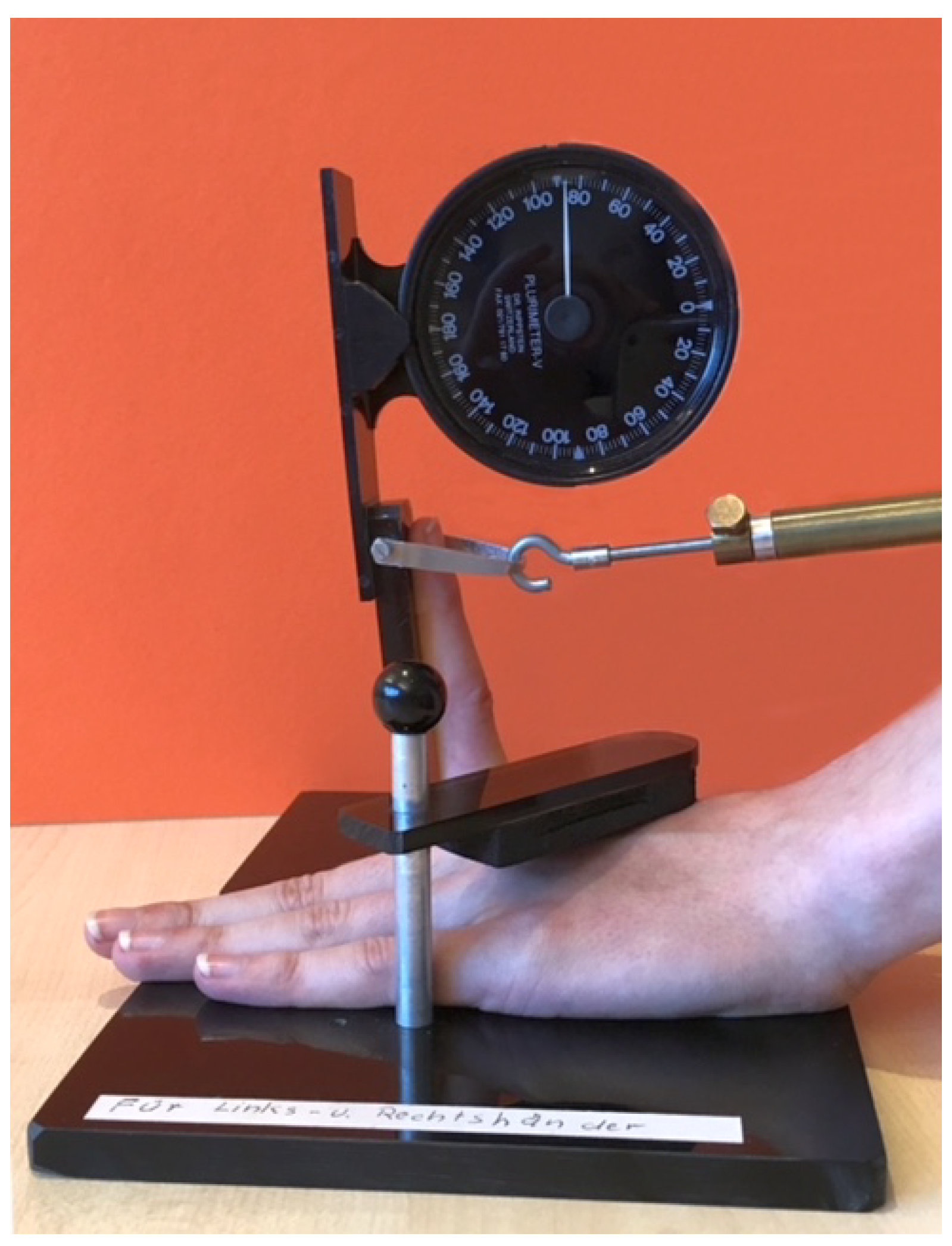
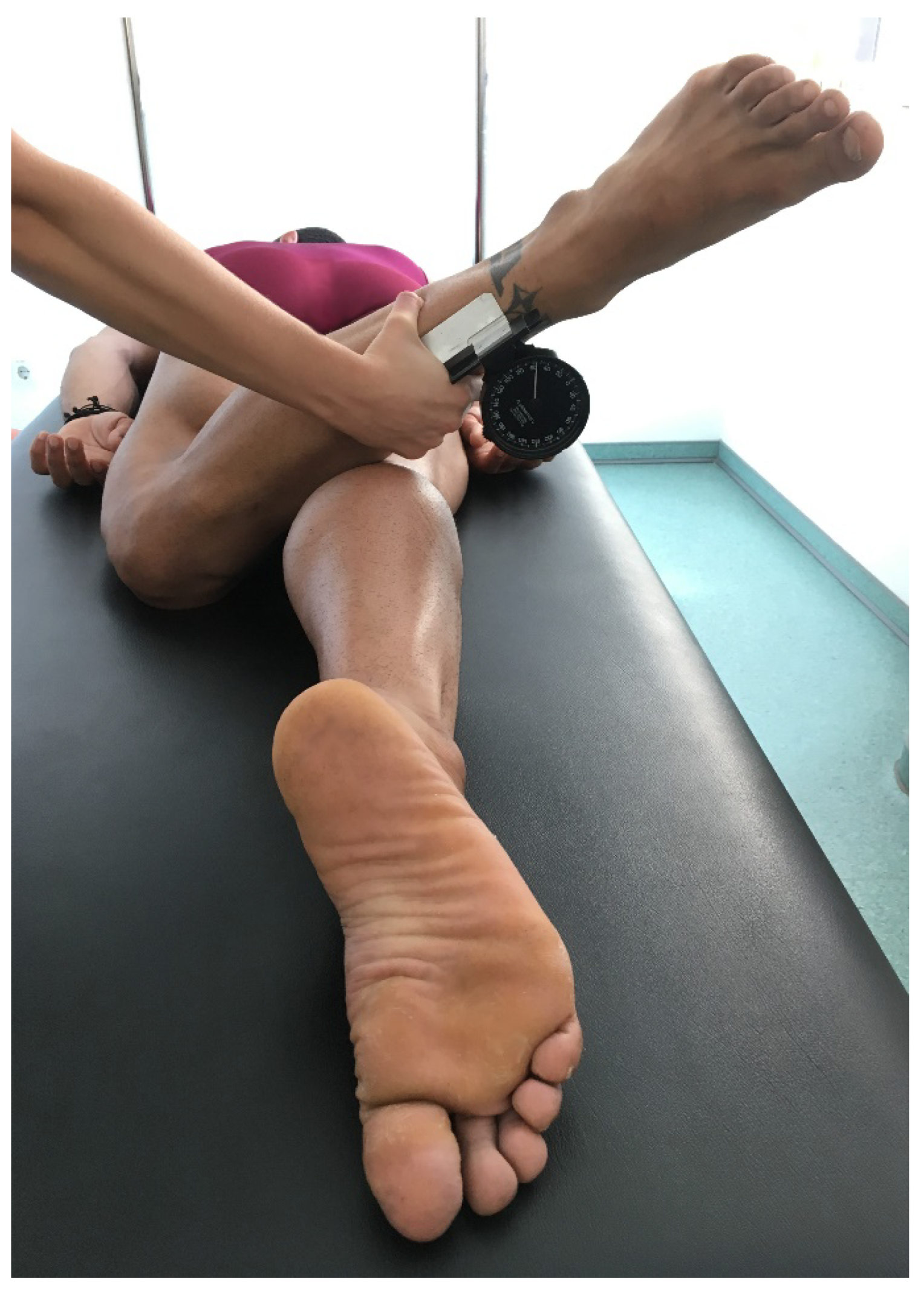
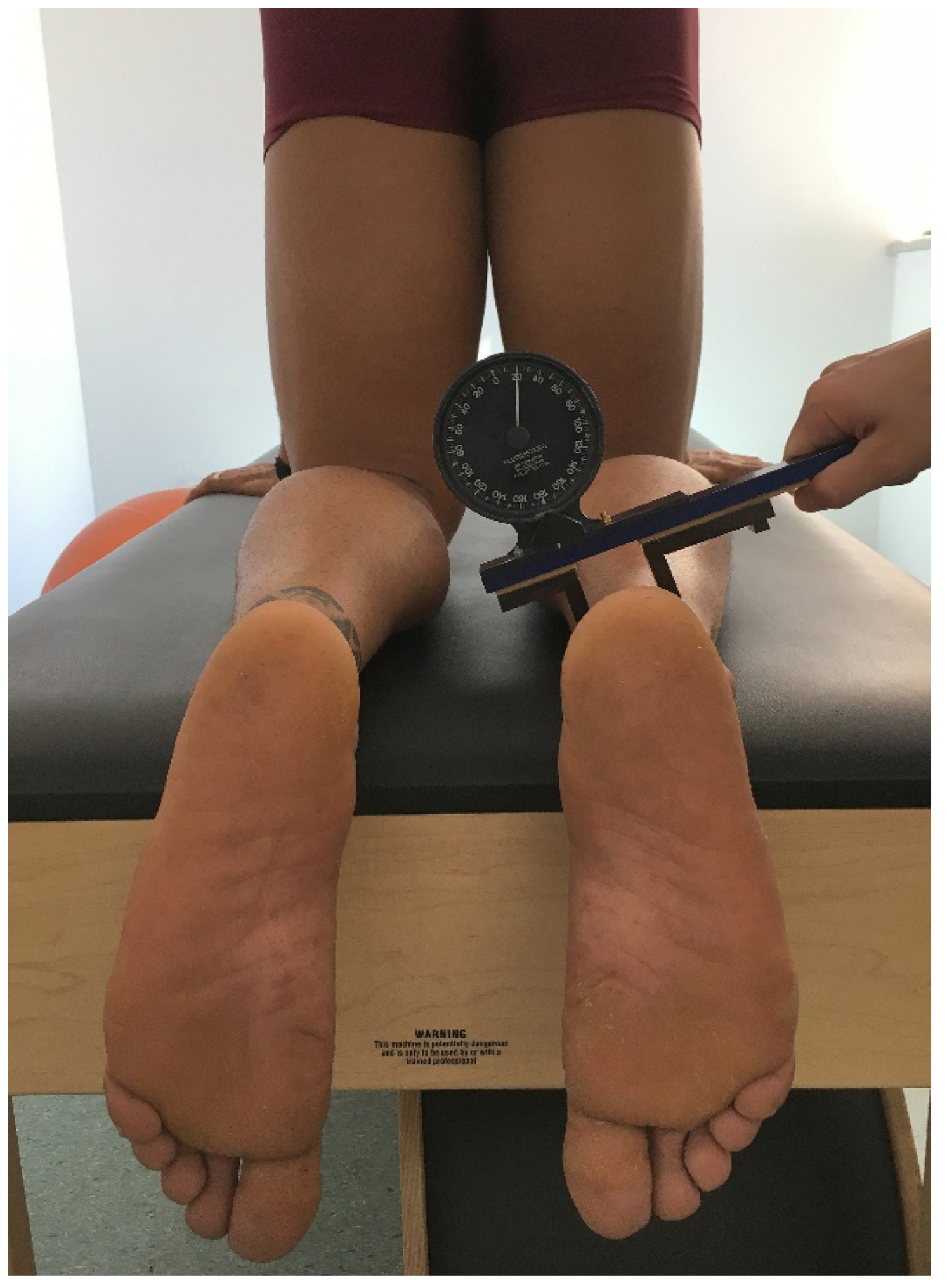
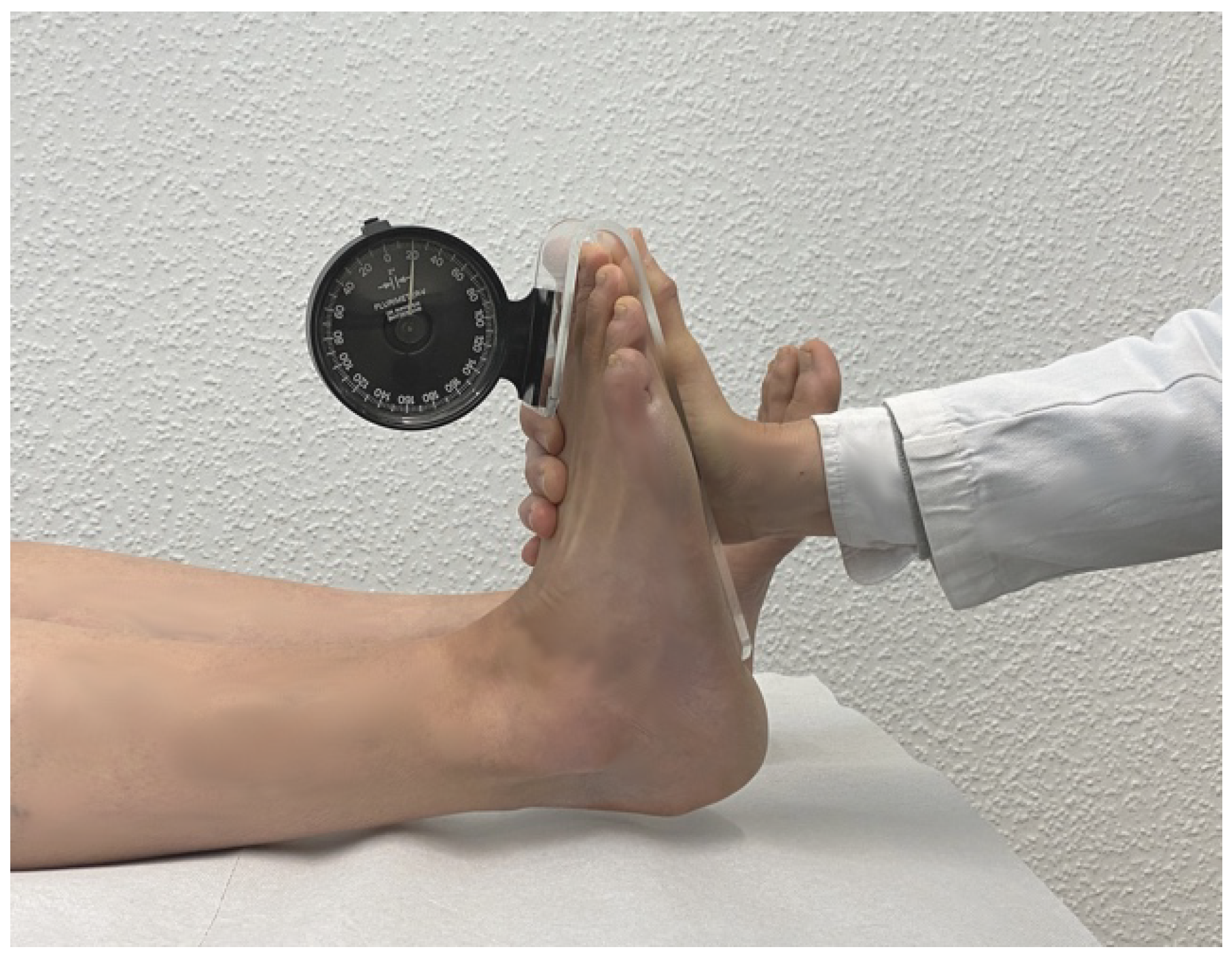
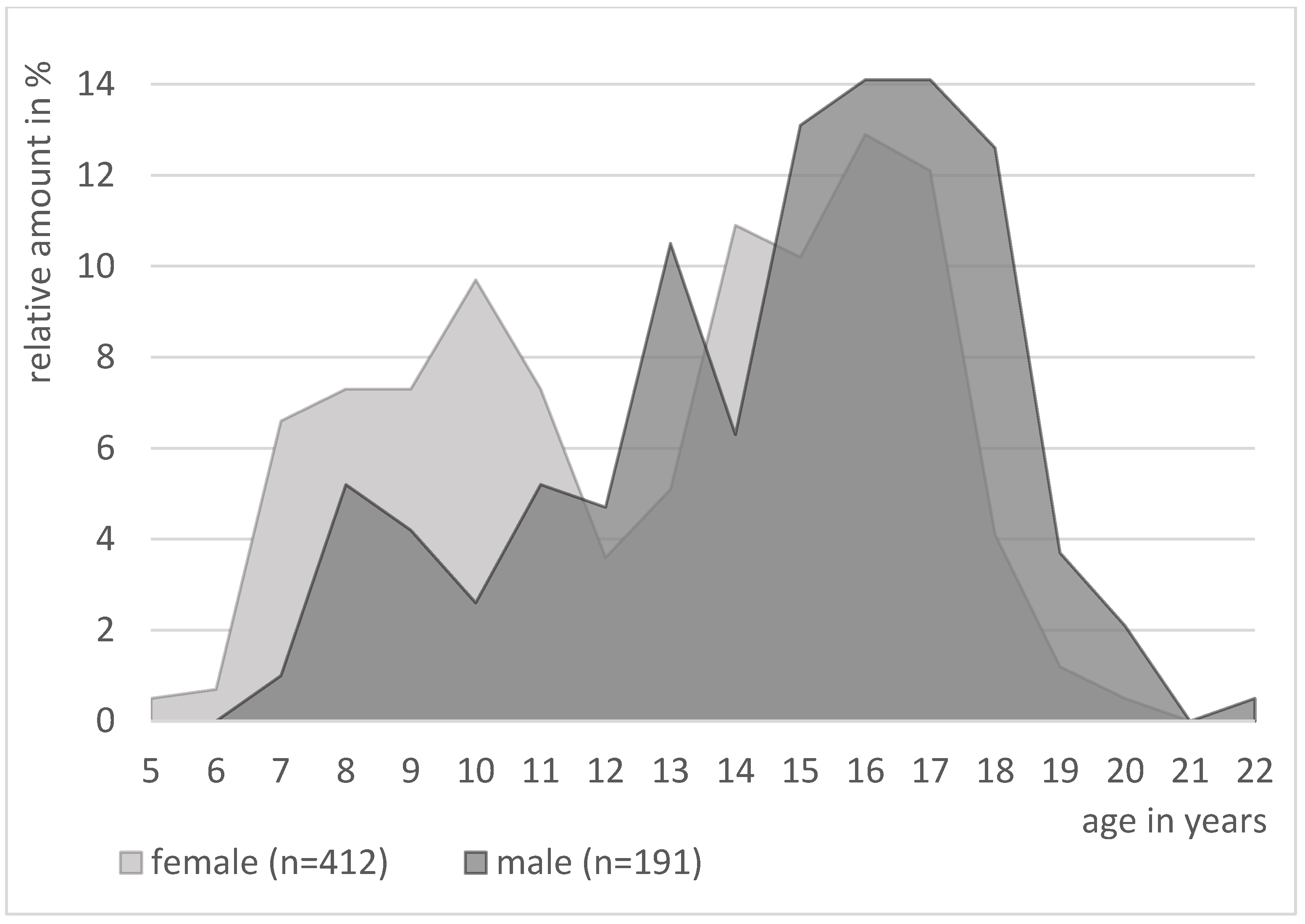

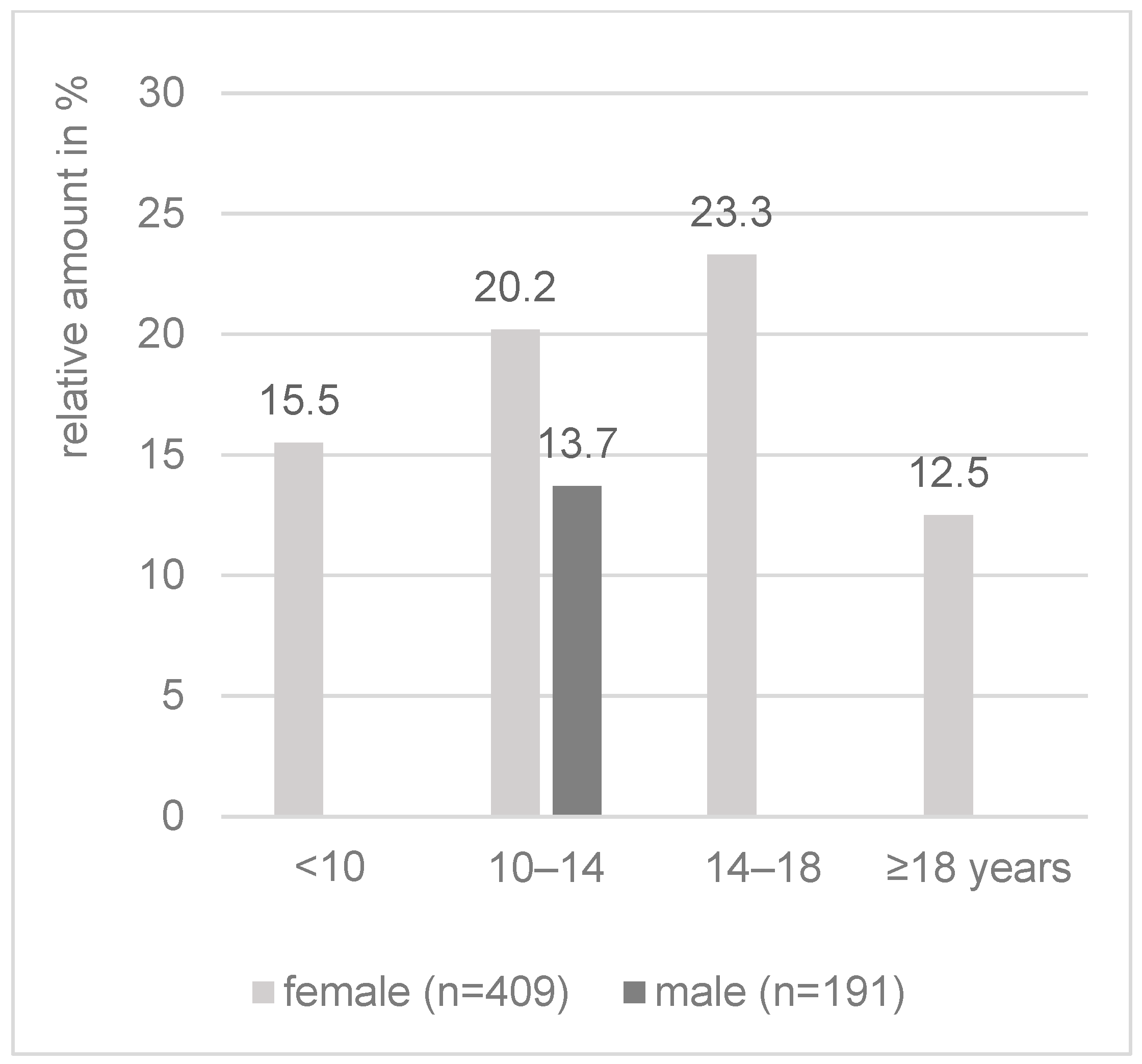
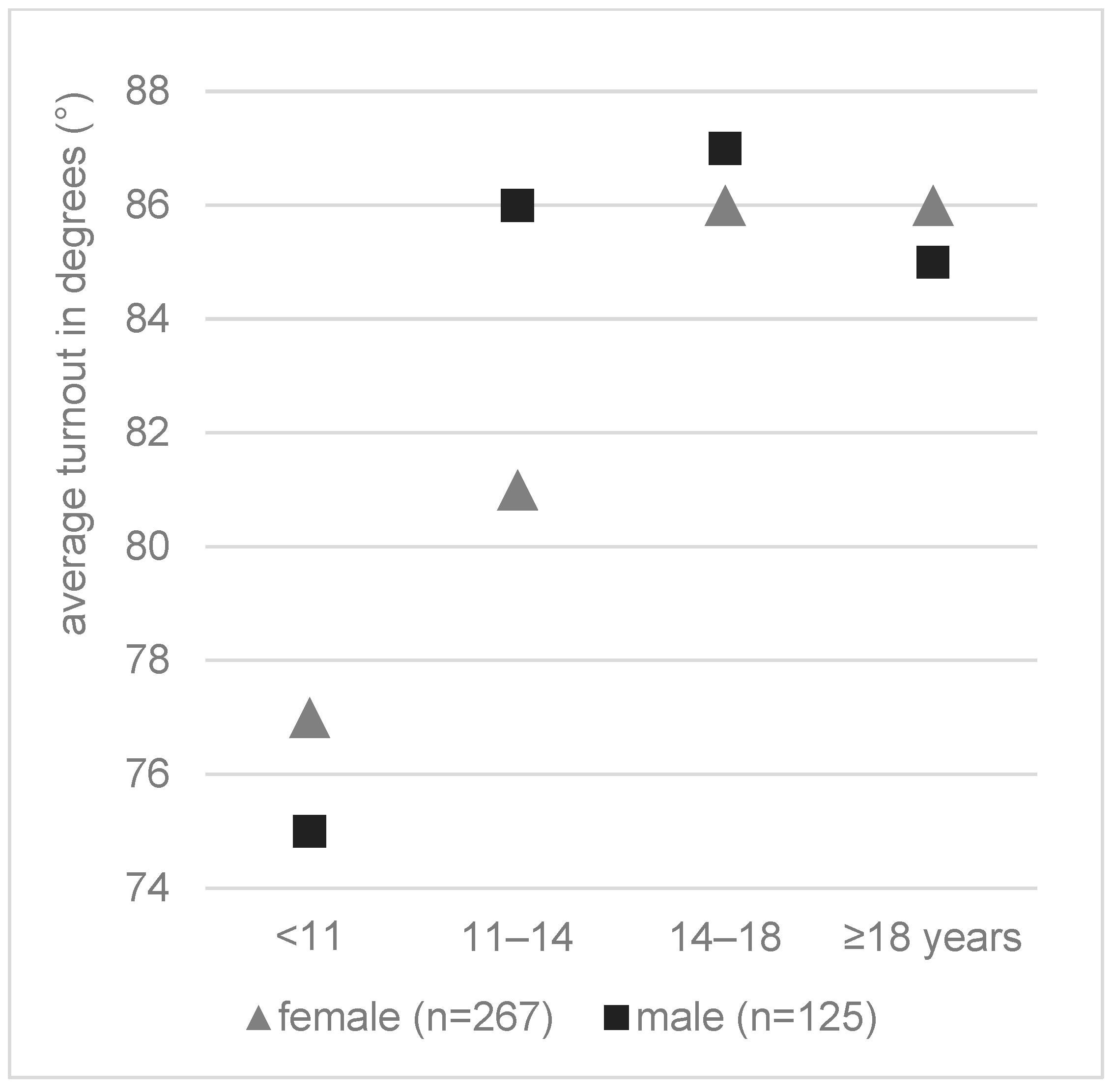
| Characteristic (Unit) | n (f/m) | ||
|---|---|---|---|
| Age (a) | 412/191 | ||
| Sociodemographic | Vision aid (yes/no) | 403/189 | |
| Commenced with | Ballet (a) | 392/185 | |
| Training (a) | 124/69 | ||
| Anthropometry | Body | Height (cm) | 412/191 |
| Weight (kg) | 412/191 | ||
| Shoulder girdle | Symmetry * | 397/186 | |
| Waist triangle | Symmetry * | 402/190 | |
| Pelvis | Anterior/Posterior tilt * | 382/184 | |
| Lateral tilt * | 400/187 | ||
| Spine | Curvature * | 403/189 | |
| Leg | Axis * | 402/186 | |
| Length (cm) | 396/188 | ||
| Intercondylar distance (TF) | 380/172 | ||
| Tibial torsion (°) | 267/125 | ||
| Foot | Rearfoot axis * | 402/189 | |
| Instep * | 59/27 | ||
| Longitudinal arch * | 374/177 | ||
| Transversal arch * | 392/185 | ||
| Big toe axis * | 404/189 | ||
| Shape * | 397/188 | ||
| Functionality | Hand | iMCP dorsiflexion (°) | 244/148 |
| Spine | Mobility * | 402/186 | |
| Hip | ER/IR (°) | 412/192 | |
| Knee | Extension (°) | 390/184 | |
| Ankle joint | Extension/Flexion (°) | 358/176 | |
| Tarsus | Mobility * | 105/59 | |
| MTP joint | Extension (°) | 392/184 | |
| Flexion (°) | 391/184 |
| Characteristic (Unit) | Female | Male | n (f/m) |
|---|---|---|---|
| Age (a) | 13.4 ± 3.5 (5.8–20.4) | 15.1 *** ± 3.2 (7.2–22.6) | 412/191 |
| Body height (cm) | 152.4 ± 16.0 (113–179) | 166.2 *** ± 16.7 (121–197.5) | 412/191 |
| Body weight (kg) | 38.5 ± 11.4 (17–64.6) | 52.7 *** ± 14.6 (21–95) | 412/191 |
| BMI (kg/m2) | 16.1 ± 2.0 (11.3–22.2) | 18.5 *** ± 2.3 (13.3–24.4) | 411/192 |
| BMI percentile ** a | 11.5 ± 12.0 (< 1–73) | 31.3 *** ± 20.5 (< 1–86) | 385/155 |
| Commenced with | |||
| Ballet (a) | 5.8 ± 2.3 (2–14) | 8.2 *** ± 2.9 (2–18) | 392/185 |
| Training (a) | 13.5 ± 3.1 (6–18) | 14.6 * ± 3.1 (5–20) | 124/69 |
| Characteristic | Female | Male | n (f/m) | |
|---|---|---|---|---|
| Shoulder girdle | symmetrical | 76.6 | 86.6 ** | 397/186 |
| asymmetrical | 23.4 | 13.4 ** | ||
| Waist triangle | symmetrical | 71.1 | 83.2 * | 402/190 |
| asymmetrical | 28.9 | 16.9 * | ||
| Anterior/Posterior | physiological | 80.4 | 85.3 | 382/184 |
| pelvic tilt | anterior tilt | 17.3 | 8.7 ** | |
| posterior tilt | 2.4 | 6 | ||
| Lateral pelvic tilt | straight | 83.8 | 87.2 | 400/187 |
| tilted | 16.3 | 12.9 | ||
| Spine | vertical | 58.8 | 65.6 | 403/189 |
| Scoliosis | 27.5 | 20.1 | ||
| scol. malposition | 10.4 | 7.4 | ||
| flatback | 1 | 5.3 ** | ||
| Kyph./Hyperlord. | 2.2 | 1.6 |
| Characteristic (Unit) | Female | Male | n (f/m) |
|---|---|---|---|
| Leg Length (cm) | 82.8 ± 9.7 (59.0–101.0) | 90.7 *** ± 10.1 (62.0–110.0) | 396/188 |
| ICD (TF) | 0.7 ± 1.1 (0–5) | 1.1 *** ± 1.4 (0–7) | 380/172 |
| TT (°) | 22.2 ± 6.4 (2–40) | 22.8 * ± 5.9 (5–38) | 267/125 |
| ER (°) | 59.1 ± 7.7 (35–75) | 61.9 *** ± 6.8 (40–80) | 412/192 |
| IR (°) | 46.4 ± 10.1 (18–72) | 37.1 *** ± 11.1 (10–70) | 412/192 |
| ROM (ER + IR) (°) | 105.5 ± 9.6 (78–138.5) | 99.0 *** ± 10.6 (72.5–130.0) | 412/192 |
| Characteristic | Female | Male | n (f/m) | |
|---|---|---|---|---|
| RFA | valgic | 32.1 | 24.3 | 402/189 |
| straight | 57 | 59.3 | ||
| varic | 10.9 | 16.4 | ||
| Instep | high | 39 | 40.7 | 59/27 |
| normal | 23.7 | 11.1 | ||
| low | 37.3 | 48.1 | ||
| Arch (l) | lowered | 84 | 87 | 374/177 |
| preserved | 14.4 | 10.7 | ||
| sperelevated | 1.6 | 2.3 | ||
| Arch (t) | splayed | 53.8 | 49.7 | 392/185 |
| not splayed | 46.2 | 50.3 | ||
| Shape | egyptian | 42.3 | 48.9 | 397/188 |
| greek | 37.8 | 37.8 | ||
| roman | 11.1 | 8 | ||
| interform | 8.8 | 5.3 | ||
| Tarsus | flexible | 75.2 | 61 | 105/59 |
| normal | 14.3 | 18.6 | ||
| rigid | 10.5 | 20.3 |
| Characteristic | Female | Male | n (f/m) | |
|---|---|---|---|---|
| Ankle joint | dorsiflexion plantarflexion | 24.1 ± 4.8 (5–40) | 22.7 *** ± 4.7 (10–45) | 358/176 |
| 71.2 ± 7.4 (40–90) | 67.9 *** ± 7.6 (50–90) | 358/176 | ||
| MTP joint | Dorsiflexion plantarflexion | 90.0 ± 4.6 (70–110) | 86.7 *** ± 8.4 (40–100) | 392/184 |
| 62.4 ± 5.1 (50–90) | 61.9 ± 5.4 (50–80) | 391/184 |
Disclaimer/Publisher’s Note: The statements, opinions and data contained in all publications are solely those of the individual author(s) and contributor(s) and not of MDPI and/or the editor(s). MDPI and/or the editor(s) disclaim responsibility for any injury to people or property resulting from any ideas, methods, instructions or products referred to in the content. |
© 2022 by the authors. Licensee MDPI, Basel, Switzerland. This article is an open access article distributed under the terms and conditions of the Creative Commons Attribution (CC BY) license (https://creativecommons.org/licenses/by/4.0/).
Share and Cite
Almasi, T.; Exner-Grave, E.; Ohlendorf, D.; Wanke, E.M. Musculoskeletal and Sociodemographic Gender Differences between Vocational Ballet Students. Appl. Sci. 2023, 13, 108. https://doi.org/10.3390/app13010108
Almasi T, Exner-Grave E, Ohlendorf D, Wanke EM. Musculoskeletal and Sociodemographic Gender Differences between Vocational Ballet Students. Applied Sciences. 2023; 13(1):108. https://doi.org/10.3390/app13010108
Chicago/Turabian StyleAlmasi, Tobias, Elisabeth Exner-Grave, Daniela Ohlendorf, and Eileen M. Wanke. 2023. "Musculoskeletal and Sociodemographic Gender Differences between Vocational Ballet Students" Applied Sciences 13, no. 1: 108. https://doi.org/10.3390/app13010108
APA StyleAlmasi, T., Exner-Grave, E., Ohlendorf, D., & Wanke, E. M. (2023). Musculoskeletal and Sociodemographic Gender Differences between Vocational Ballet Students. Applied Sciences, 13(1), 108. https://doi.org/10.3390/app13010108








